seats NISSAN 370Z 2020 Owner´s Manual
[x] Cancel search | Manufacturer: NISSAN, Model Year: 2020, Model line: 370Z, Model: NISSAN 370Z 2020Pages: 455, PDF Size: 2.22 MB
Page 39 of 455
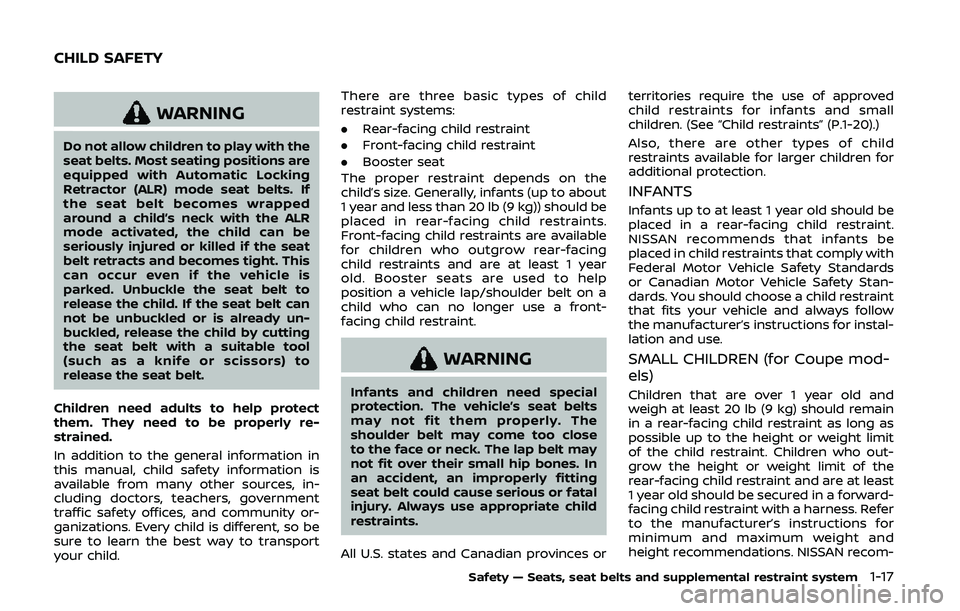
WARNING
Do not allow children to play with the
seat belts. Most seating positions are
equipped with Automatic Locking
Retractor (ALR) mode seat belts. If
the seat belt becomes wrapped
around a child’s neck with the ALR
mode activated, the child can be
seriously injured or killed if the seat
belt retracts and becomes tight. This
can occur even if the vehicle is
parked. Unbuckle the seat belt to
release the child. If the seat belt can
not be unbuckled or is already un-
buckled, release the child by cutting
the seat belt with a suitable tool
(such as a knife or scissors) to
release the seat belt.
Children need adults to help protect
them. They need to be properly re-
strained.
In addition to the general information in
this manual, child safety information is
available from many other sources, in-
cluding doctors, teachers, government
traffic safety offices, and community or-
ganizations. Every child is different, so be
sure to learn the best way to transport
your child. There are three basic types of child
restraint systems:
.
Rear-facing child restraint
. Front-facing child restraint
. Booster seat
The proper restraint depends on the
child’s size. Generally, infants (up to about
1 year and less than 20 lb (9 kg)) should be
placed in rear-facing child restraints.
Front-facing child restraints are available
for children who outgrow rear-facing
child restraints and are at least 1 year
old. Booster seats are used to help
position a vehicle lap/shoulder belt on a
child who can no longer use a front-
facing child restraint.
WARNING
Infants and children need special
protection. The vehicle’s seat belts
may not fit them properly. The
shoulder belt may come too close
to the face or neck. The lap belt may
not fit over their small hip bones. In
an accident, an improperly fitting
seat belt could cause serious or fatal
injury. Always use appropriate child
restraints.
All U.S. states and Canadian provinces or territories require the use of approved
child restraints for infants and small
children. (See “Child restraints” (P.1-20).)
Also, there are other types of child
restraints available for larger children for
additional protection.
INFANTS
Infants up to at least 1 year old should be
placed in a rear-facing child restraint.
NISSAN recommends that infants be
placed in child restraints that comply with
Federal Motor Vehicle Safety Standards
or Canadian Motor Vehicle Safety Stan-
dards. You should choose a child restraint
that fits your vehicle and always follow
the manufacturer’s instructions for instal-
lation and use.
SMALL CHILDREN (for Coupe mod-
els)
Children that are over 1 year old and
weigh at least 20 lb (9 kg) should remain
in a rear-facing child restraint as long as
possible up to the height or weight limit
of the child restraint. Children who out-
grow the height or weight limit of the
rear-facing child restraint and are at least
1 year old should be secured in a forward-
facing child restraint with a harness. Refer
to the manufacturer’s instructions for
minimum and maximum weight and
height recommendations. NISSAN recom-
Safety — Seats, seat belts and supplemental restraint system1-17
CHILD SAFETY
Page 40 of 455
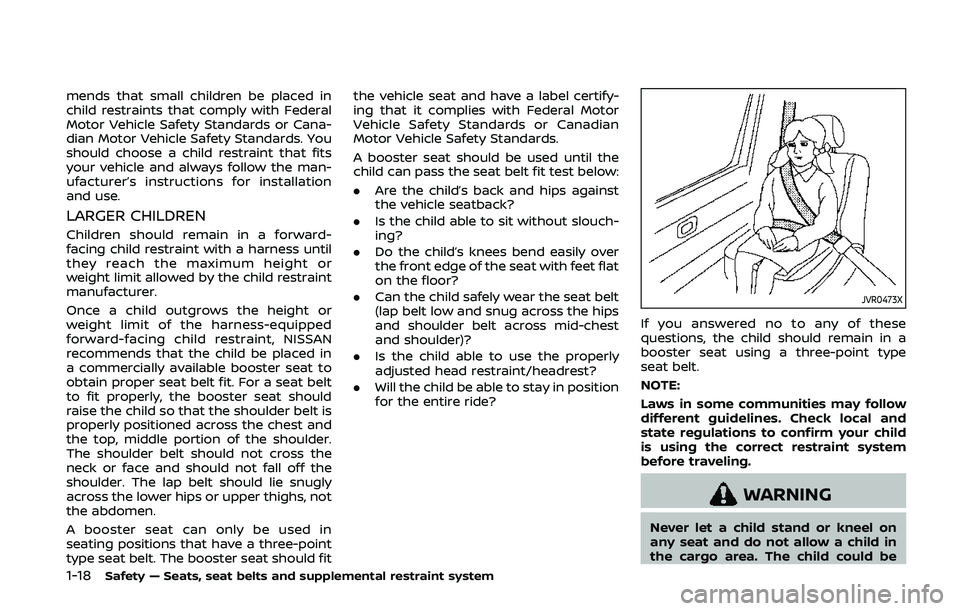
1-18Safety — Seats, seat belts and supplemental restraint system
mends that small children be placed in
child restraints that comply with Federal
Motor Vehicle Safety Standards or Cana-
dian Motor Vehicle Safety Standards. You
should choose a child restraint that fits
your vehicle and always follow the man-
ufacturer’s instructions for installation
and use.
LARGER CHILDREN
Children should remain in a forward-
facing child restraint with a harness until
they reach the maximum height or
weight limit allowed by the child restraint
manufacturer.
Once a child outgrows the height or
weight limit of the harness-equipped
forward-facing child restraint, NISSAN
recommends that the child be placed in
a commercially available booster seat to
obtain proper seat belt fit. For a seat belt
to fit properly, the booster seat should
raise the child so that the shoulder belt is
properly positioned across the chest and
the top, middle portion of the shoulder.
The shoulder belt should not cross the
neck or face and should not fall off the
shoulder. The lap belt should lie snugly
across the lower hips or upper thighs, not
the abdomen.
A booster seat can only be used in
seating positions that have a three-point
type seat belt. The booster seat should fitthe vehicle seat and have a label certify-
ing that it complies with Federal Motor
Vehicle Safety Standards or Canadian
Motor Vehicle Safety Standards.
A booster seat should be used until the
child can pass the seat belt fit test below:
.
Are the child’s back and hips against
the vehicle seatback?
. Is the child able to sit without slouch-
ing?
. Do the child’s knees bend easily over
the front edge of the seat with feet flat
on the floor?
. Can the child safely wear the seat belt
(lap belt low and snug across the hips
and shoulder belt across mid-chest
and shoulder)?
. Is the child able to use the properly
adjusted head restraint/headrest?
. Will the child be able to stay in position
for the entire ride?
JVR0473X
If you answered no to any of these
questions, the child should remain in a
booster seat using a three-point type
seat belt.
NOTE:
Laws in some communities may follow
different guidelines. Check local and
state regulations to confirm your child
is using the correct restraint system
before traveling.
WARNING
Never let a child stand or kneel on
any seat and do not allow a child in
the cargo area. The child could be
Page 41 of 455
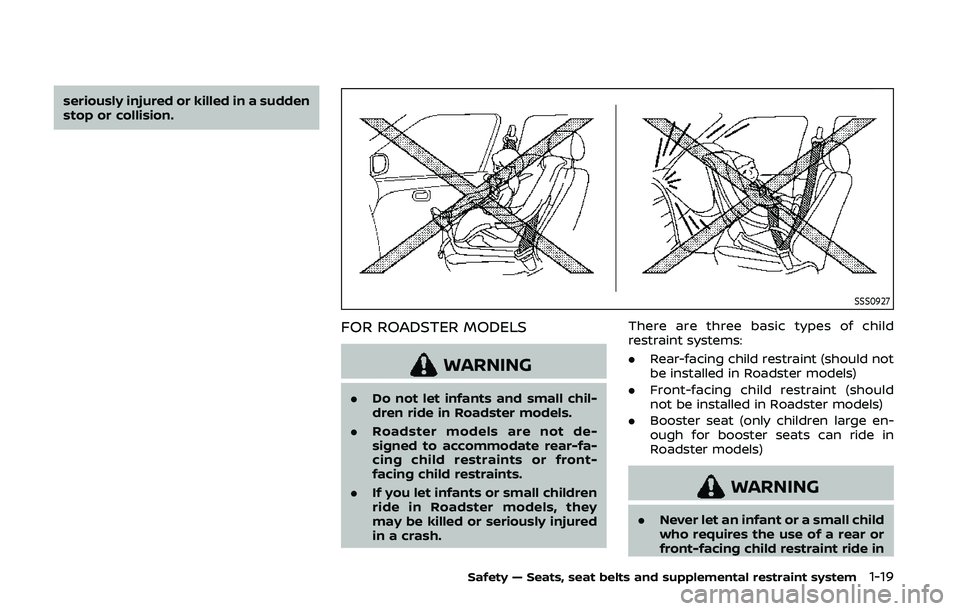
seriously injured or killed in a sudden
stop or collision.
SSS0927
FOR ROADSTER MODELS
WARNING
.Do not let infants and small chil-
dren ride in Roadster models.
. Roadster models are not de-
signed to accommodate rear-fa-
cing child restraints or front-
facing child restraints.
. If you let infants or small children
ride in Roadster models, they
may be killed or seriously injured
in a crash. There are three basic types of child
restraint systems:
.
Rear-facing child restraint (should not
be installed in Roadster models)
. Front-facing child restraint (should
not be installed in Roadster models)
. Booster seat (only children large en-
ough for booster seats can ride in
Roadster models)
WARNING
.Never let an infant or a small child
who requires the use of a rear or
front-facing child restraint ride in
Safety — Seats, seat belts and supplemental restraint system1-19
Page 42 of 455
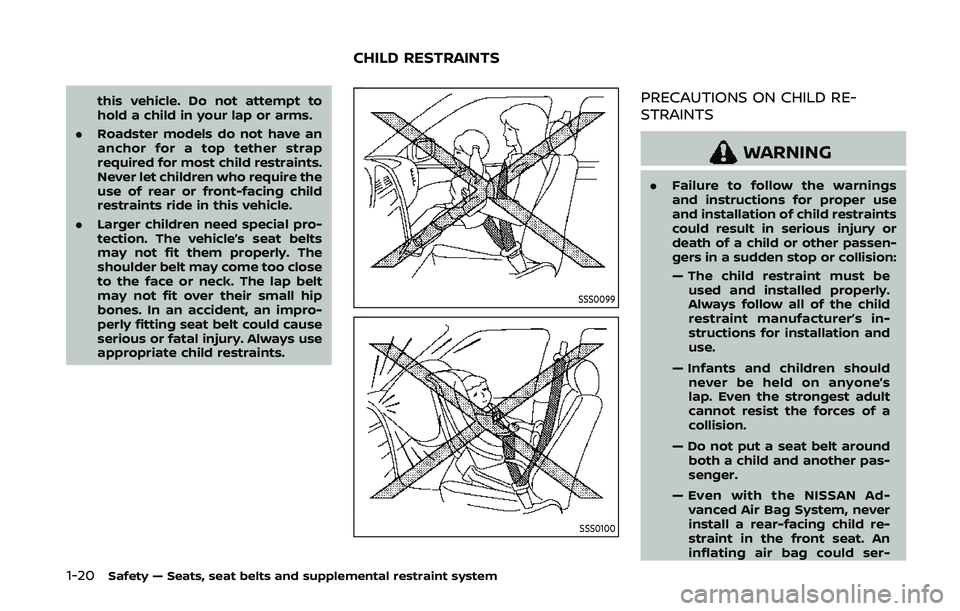
1-20Safety — Seats, seat belts and supplemental restraint system
this vehicle. Do not attempt to
hold a child in your lap or arms.
. Roadster models do not have an
anchor for a top tether strap
required for most child restraints.
Never let children who require the
use of rear or front-facing child
restraints ride in this vehicle.
. Larger children need special pro-
tection. The vehicle’s seat belts
may not fit them properly. The
shoulder belt may come too close
to the face or neck. The lap belt
may not fit over their small hip
bones. In an accident, an impro-
perly fitting seat belt could cause
serious or fatal injury. Always use
appropriate child restraints.
SSS0099
SSS0100
PRECAUTIONS ON CHILD RE-
STRAINTS
WARNING
.Failure to follow the warnings
and instructions for proper use
and installation of child restraints
could result in serious injury or
death of a child or other passen-
gers in a sudden stop or collision:
— The child restraint must be
used and installed properly.
Always follow all of the child
restraint manufacturer’s in-
structions for installation and
use.
— Infants and children should never be held on anyone’s
lap. Even the strongest adult
cannot resist the forces of a
collision.
— Do not put a seat belt around both a child and another pas-
senger.
— Even with the NISSAN Ad- vanced Air Bag System, never
install a rear-facing child re-
straint in the front seat. An
inflating air bag could ser-
CHILD RESTRAINTS
Page 43 of 455
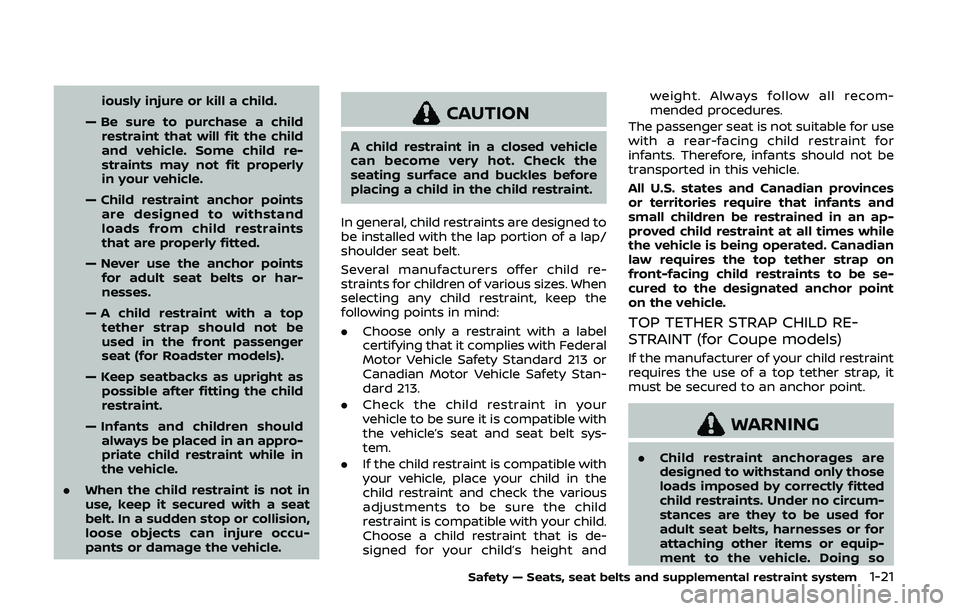
iously injure or kill a child.
— Be sure to purchase a child restraint that will fit the child
and vehicle. Some child re-
straints may not fit properly
in your vehicle.
— Child restraint anchor points are designed to withstand
loads from child restraints
that are properly fitted.
— Never use the anchor points for adult seat belts or har-
nesses.
— A child restraint with a top tether strap should not be
used in the front passenger
seat (for Roadster models).
— Keep seatbacks as upright as possible after fitting the child
restraint.
— Infants and children should always be placed in an appro-
priate child restraint while in
the vehicle.
. When the child restraint is not in
use, keep it secured with a seat
belt. In a sudden stop or collision,
loose objects can injure occu-
pants or damage the vehicle.CAUTION
A child restraint in a closed vehicle
can become very hot. Check the
seating surface and buckles before
placing a child in the child restraint.
In general, child restraints are designed to
be installed with the lap portion of a lap/
shoulder seat belt.
Several manufacturers offer child re-
straints for children of various sizes. When
selecting any child restraint, keep the
following points in mind:
. Choose only a restraint with a label
certifying that it complies with Federal
Motor Vehicle Safety Standard 213 or
Canadian Motor Vehicle Safety Stan-
dard 213.
. Check the child restraint in your
vehicle to be sure it is compatible with
the vehicle’s seat and seat belt sys-
tem.
. If the child restraint is compatible with
your vehicle, place your child in the
child restraint and check the various
adjustments to be sure the child
restraint is compatible with your child.
Choose a child restraint that is de-
signed for your child’s height and weight. Always follow all recom-
mended procedures.
The passenger seat is not suitable for use
with a rear-facing child restraint for
infants. Therefore, infants should not be
transported in this vehicle.
All U.S. states and Canadian provinces
or territories require that infants and
small children be restrained in an ap-
proved child restraint at all times while
the vehicle is being operated. Canadian
law requires the top tether strap on
front-facing child restraints to be se-
cured to the designated anchor point
on the vehicle.
TOP TETHER STRAP CHILD RE-
STRAINT (for Coupe models)
If the manufacturer of your child restraint
requires the use of a top tether strap, it
must be secured to an anchor point.
WARNING
. Child restraint anchorages are
designed to withstand only those
loads imposed by correctly fitted
child restraints. Under no circum-
stances are they to be used for
adult seat belts, harnesses or for
attaching other items or equip-
ment to the vehicle. Doing so
Safety — Seats, seat belts and supplemental restraint system1-21
Page 44 of 455
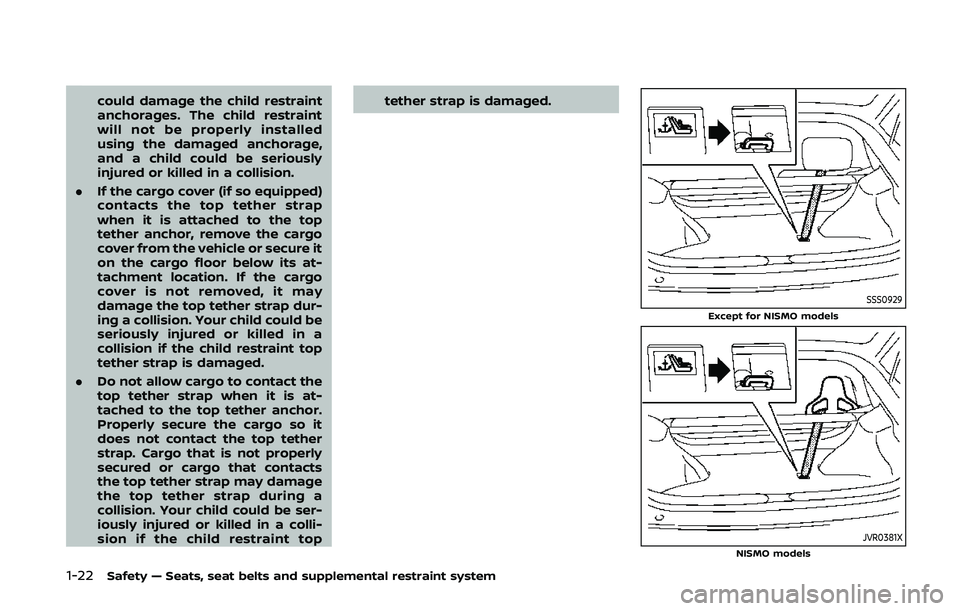
1-22Safety — Seats, seat belts and supplemental restraint system
could damage the child restraint
anchorages. The child restraint
will not be properly installed
using the damaged anchorage,
and a child could be seriously
injured or killed in a collision.
. If the cargo cover (if so equipped)
contacts the top tether strap
when it is attached to the top
tether anchor, remove the cargo
cover from the vehicle or secure it
on the cargo floor below its at-
tachment location. If the cargo
cover is not removed, it may
damage the top tether strap dur-
ing a collision. Your child could be
seriously injured or killed in a
collision if the child restraint top
tether strap is damaged.
. Do not allow cargo to contact the
top tether strap when it is at-
tached to the top tether anchor.
Properly secure the cargo so it
does not contact the top tether
strap. Cargo that is not properly
secured or cargo that contacts
the top tether strap may damage
the top tether strap during a
collision. Your child could be ser-
iously injured or killed in a colli-
sion if the child restraint top tether strap is damaged.
SSS0929Except for NISMO models
JVR0381XNISMO models
Page 45 of 455
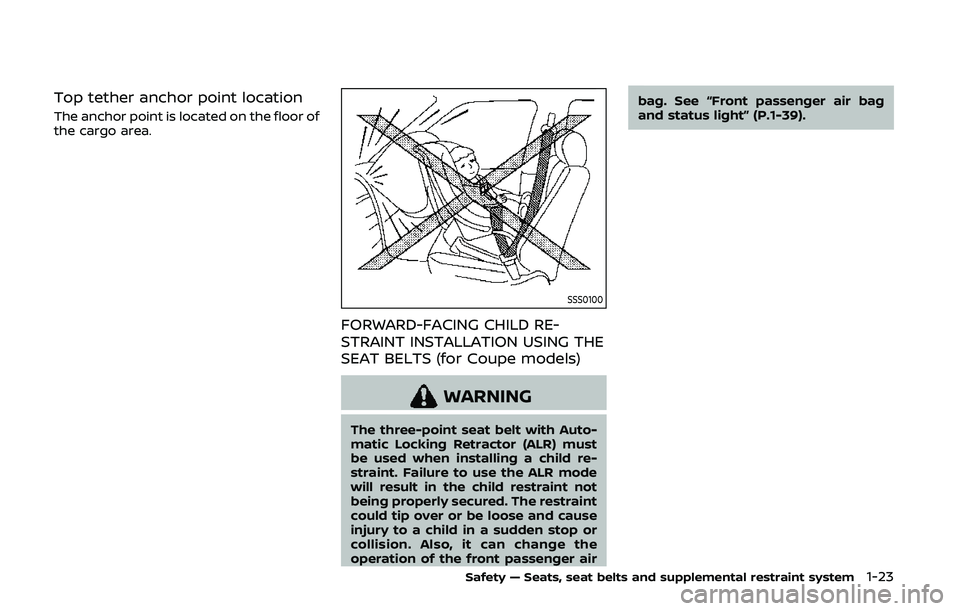
Top tether anchor point location
The anchor point is located on the floor of
the cargo area.
SSS0100
FORWARD-FACING CHILD RE-
STRAINT INSTALLATION USING THE
SEAT BELTS (for Coupe models)
WARNING
The three-point seat belt with Auto-
matic Locking Retractor (ALR) must
be used when installing a child re-
straint. Failure to use the ALR mode
will result in the child restraint not
being properly secured. The restraint
could tip over or be loose and cause
injury to a child in a sudden stop or
collision. Also, it can change the
operation of the front passenger airbag. See “Front passenger air bag
and status light” (P.1-39).
Safety — Seats, seat belts and supplemental restraint system1-23
Page 46 of 455
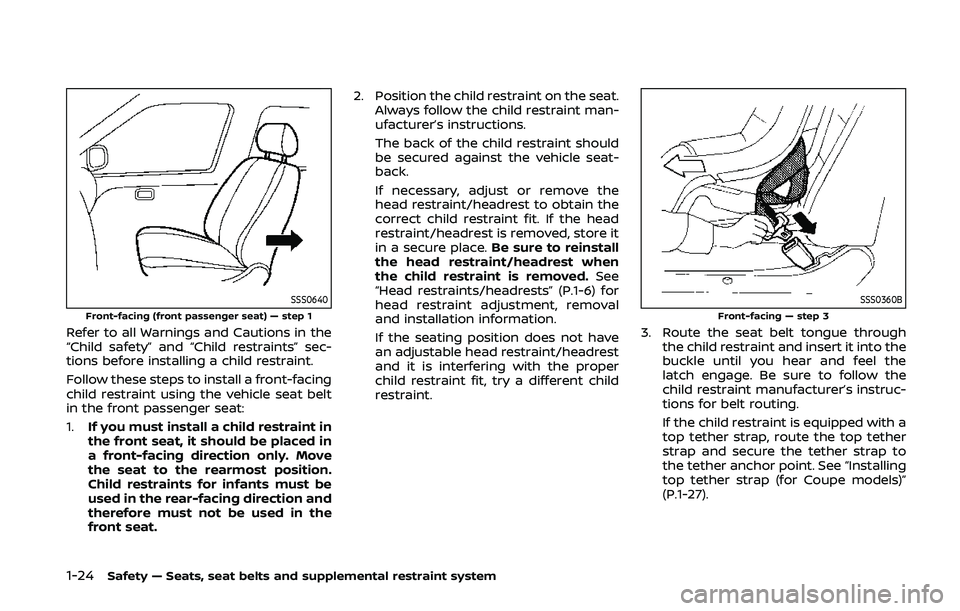
1-24Safety — Seats, seat belts and supplemental restraint system
SSS0640Front-facing (front passenger seat) — step 1
Refer to all Warnings and Cautions in the
“Child safety” and “Child restraints” sec-
tions before installing a child restraint.
Follow these steps to install a front-facing
child restraint using the vehicle seat belt
in the front passenger seat:
1.If you must install a child restraint in
the front seat, it should be placed in
a front-facing direction only. Move
the seat to the rearmost position.
Child restraints for infants must be
used in the rear-facing direction and
therefore must not be used in the
front seat. 2. Position the child restraint on the seat.
Always follow the child restraint man-
ufacturer’s instructions.
The back of the child restraint should
be secured against the vehicle seat-
back.
If necessary, adjust or remove the
head restraint/headrest to obtain the
correct child restraint fit. If the head
restraint/headrest is removed, store it
in a secure place. Be sure to reinstall
the head restraint/headrest when
the child restraint is removed. See
“Head restraints/headrests” (P.1-6) for
head restraint adjustment, removal
and installation information.
If the seating position does not have
an adjustable head restraint/headrest
and it is interfering with the proper
child restraint fit, try a different child
restraint.
SSS0360BFront-facing — step 3
3. Route the seat belt tongue through
the child restraint and insert it into the
buckle until you hear and feel the
latch engage. Be sure to follow the
child restraint manufacturer’s instruc-
tions for belt routing.
If the child restraint is equipped with a
top tether strap, route the top tether
strap and secure the tether strap to
the tether anchor point. See “Installing
top tether strap (for Coupe models)”
(P.1-27).
Page 47 of 455
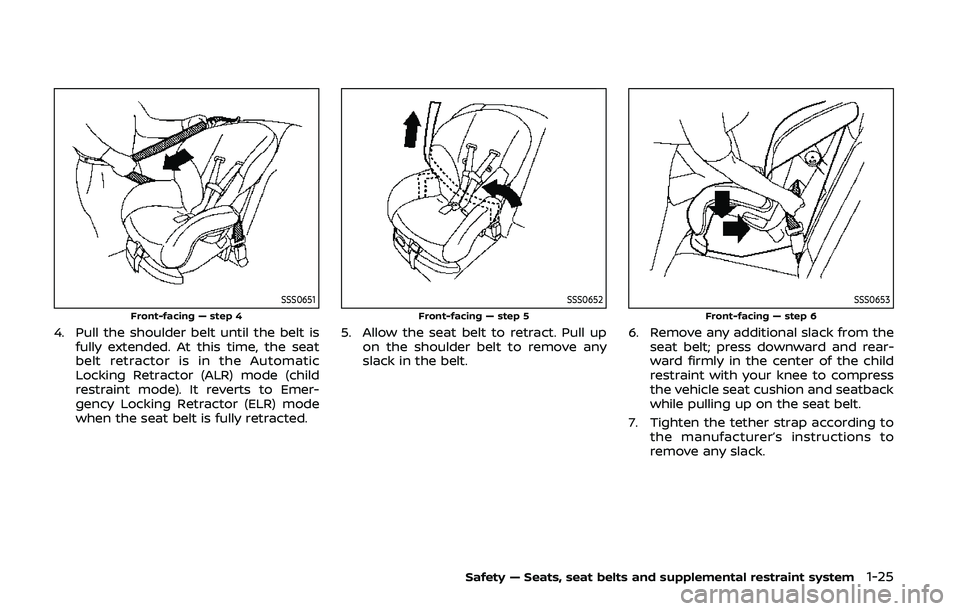
SSS0651Front-facing — step 4
4. Pull the shoulder belt until the belt isfully extended. At this time, the seat
belt retractor is in the Automatic
Locking Retractor (ALR) mode (child
restraint mode). It reverts to Emer-
gency Locking Retractor (ELR) mode
when the seat belt is fully retracted.
SSS0652Front-facing — step 5
5. Allow the seat belt to retract. Pull upon the shoulder belt to remove any
slack in the belt.
SSS0653Front-facing — step 6
6. Remove any additional slack from theseat belt; press downward and rear-
ward firmly in the center of the child
restraint with your knee to compress
the vehicle seat cushion and seatback
while pulling up on the seat belt.
7. Tighten the tether strap according to the manufacturer’s instructions to
remove any slack.
Safety — Seats, seat belts and supplemental restraint system1-25
Page 48 of 455
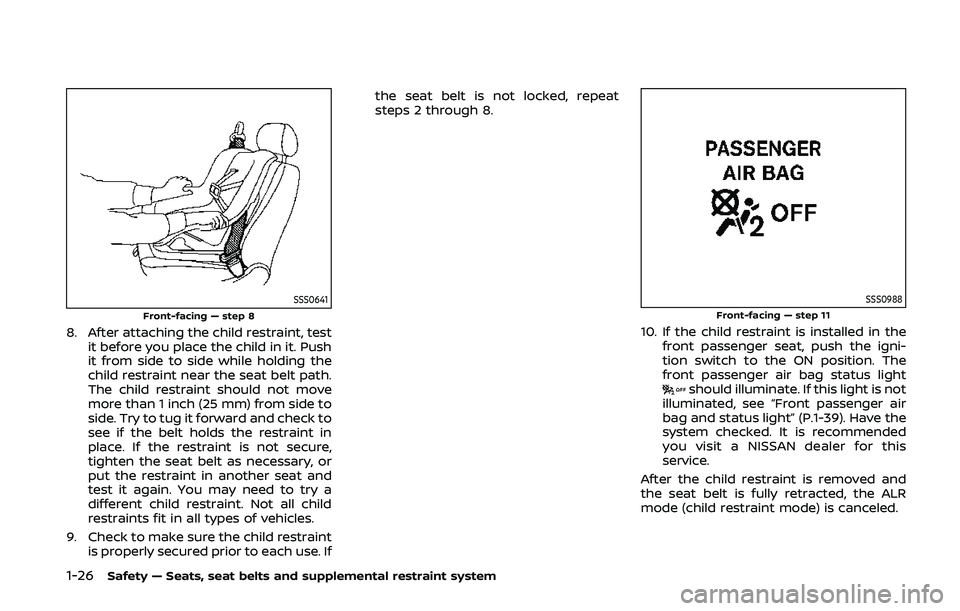
1-26Safety — Seats, seat belts and supplemental restraint system
SSS0641Front-facing — step 8
8. After attaching the child restraint, testit before you place the child in it. Push
it from side to side while holding the
child restraint near the seat belt path.
The child restraint should not move
more than 1 inch (25 mm) from side to
side. Try to tug it forward and check to
see if the belt holds the restraint in
place. If the restraint is not secure,
tighten the seat belt as necessary, or
put the restraint in another seat and
test it again. You may need to try a
different child restraint. Not all child
restraints fit in all types of vehicles.
9. Check to make sure the child restraint is properly secured prior to each use. If the seat belt is not locked, repeat
steps 2 through 8.
SSS0988Front-facing — step 11
10. If the child restraint is installed in the
front passenger seat, push the igni-
tion switch to the ON position. The
front passenger air bag status light
should illuminate. If this light is not
illuminated, see “Front passenger air
bag and status light” (P.1-39). Have the
system checked. It is recommended
you visit a NISSAN dealer for this
service.
After the child restraint is removed and
the seat belt is fully retracted, the ALR
mode (child restraint mode) is canceled.